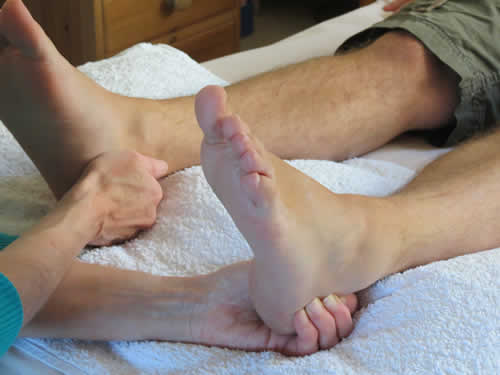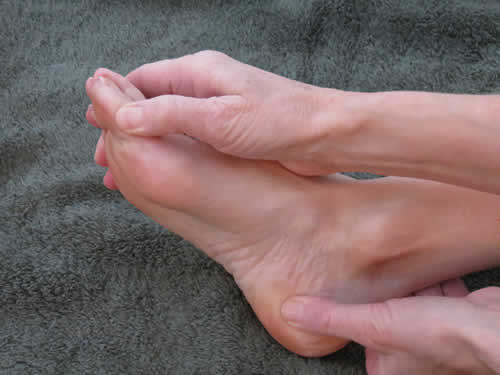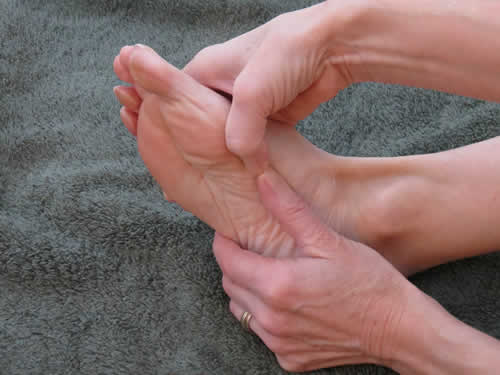Positive Health Online
Your Country

Back Issues and Reflexology Support
listed in reflexology, originally published in issue 216 - August 2014
Thousands of working hours are lost each year due to backache or back trouble, but this vague generic description can cover a wide range conditions ranging from very acute to chronic illness. So what can reflexology offer to help ease this very common form of pain and tension? Working the hand or foot, musculo-skeletal, reflexes can often bring about a feeling of relaxation and relief in any part of the back; many reflexologists also teach their clients to administer self-help techniques in between reflexology appointments.
A client and fellow tutor came to me for reflexology treatments when she developed a painful lower lumbar condition and was unable to lie down or walk for long without discomfort. I taught her the Vertical Reflexology Technique (VRT): Metatarsal Pressure, to apply to her weight-bearing foot so, whenever she felt acute pain, she applied some pressure to the lumbar foot reflexes and almost immediately experienced some relief. Whenever her back began to hurt she would stop, stand her foot on a low wall, stool or stair and bend down to work the specific foot reflexes for a minute or so and within days she reported that this muscular tension had cleared up completely. This standing technique is only suitable for persons who are generally fit, supple, and able to lean forward to apply pressure to the foot. The passive feet can also be worked to help ease back tensions (see self-help description below).
The wide-ranging scope of reflexology is illustrated by two results that describe the possible efficacy of reflexology for supporting spinal issues following very serious falls. In the cases described it was imperative that medical intervention and continued medical support formed an essential focus for recovery and the role of reflexology was seen as an adjunct to support the body’s recovery. The term ‘complementary therapy’ is a helpful description as, in many cases, both doctors and therapists can play an important part in a patient’s recovery. Minor cases of back strain, that may follow rigorous exercise or gardening, for example, can still greatly impinge on someone’s working life and their general well-being and mobility. So reflexology techniques are a useful non-invasive option to possibly aid a quicker recovery.
Reflexology Definition
The theory behind reflexology is that tension, congestion and possible disease in the body are mirrored in the feet and hands; each foot and hand represent one half of the body, and there is a corresponding reflex to every part of the body. Reflexologists do not diagnose specific conditions but if a particular reflex is tender or feels granular when stimulated, for example, it may indicate that the corresponding body area is in need of stimulation to boost its natural healing powers. Reflexology can be used on its own, with other complementary therapies and alongside mainstream medical care. It can be applied to all ages and all conditions.
Self-help Reflexology to Support Back Conditions
I recommend commencing treatment for all muscular/skeletal injuries from a fixed starting point which comprises working the hip, pelvic and lower lumbar spine reflexes first to adjust and balance the entire body, prior to specifically targeting specific reflex points. This has proved very successful, and I use this premise for adjusting the entire body via the pelvis as a blue-print for all my Reflexology/Vertical Reflex Therapy treatments. Most manual therapists recognize the maxim that structure governs function, hence the need to first make corrections to the lumbar spine area in the belief that once stability returns to the lower part of the body, then the glands, organs and muscular / skeletal system throughout the body are in a better position to respond.

FIG 1 Cradling heel reflexes to balance the pelvis
The hip and pelvic reflexes are situated round the heel of the foot and, for a general foot workout, gently press and rotate your thumb and fingers in a soft pinching, rotating movement to stimulate and relax the whole area. Duration about 1 minute per foot. This gentle stimulating technique can easily be applied, one foot at a time, for self-help.

FIG 2 Working the neck reflexes
Working the neck reflexes involves stoking, pressing and rotating your fingers and thumb round the base of the big toes. The aim is to relax the body and release muscular tension. This is an important factor in relaxing the entire spine. The base of the thumb contains neck reflexes and can also be stimulated in the same manner for approximately 1 minute.

FIG 3 working the spinal reflexes.
Press the fingers up and down the first metatarsal bone on the medial side of the foot. Once you reach the arch of the foot you are working the lumbar spine and this may be particularly tender. The feet may feel sensitive but it should not be painful so reduce the pressure if it feels uncomfortable. The medial side of the hand, below the thumb, may also be stimulated in the same way, for approximately 1 minute, to ease the back. The lumbar reflexes, at the base of the hand or foot are often the most sensitive.
Water - Essential for a Healthy Body and Hydrated Muscles
The human body consists of 75% water and all our organs and muscles respond better when properly hydrated. Thirst is not the brain’s first sign of dehydration, but one of the last, so always keep up your fluid intake. If water (the purest form of fluid) is not available, substitute weak herbal teas, preferably dilute fruit juice, but bear in mind that many drinks contain sugar stimulants. So the intake of which is best kept to a minimum. I work with professional athletes and many report feeling very stiff and achy in the morning when they first get out of bed and clients of all ages from many other walks of life report the same problem. I suggest that, if you have backache or any muscular ache on rising, you ensure that you immediately drink a glass of water as this can quickly help to rehydrate the muscles and, after extra water intake, the muscle tension often begins to ease very quickly.
Reflexology Cautions
- Always thoroughly check the feet and hands before applying reflexology;
- Look for bruises, cuts, swelling, blisters, infections, anything contagious;
- Older people, and those undergoing chemotherapy or steroid treatment, may have very thin skin, especially on their hands, and the lightest possible touch must be applied. In some cases, it is more appropriate to work the feet gently as the skin is not so thin;
- If a person has warts or veruccas a small sticking plaster should be applied at the beginning of the session to protect and cover the infectious area;
- Reflexology helps restore balance, but does not cure diseases or illnesses and should be used to support the body to maintain health.
Case Study 1: Reflexology Following a Paralysing Fall[1]
Béatrice Delaetre writes
I live in France and, in April 2011, feeling tired and exhausted, I collapsed and hit my head on the floor of the kitchen. It was a huge shock, I wanted to stand up, and I could not move. I was paralysed. The diagnosis was: compression and medullary trauma after fractured C5 and C6, causing a spasmodic tetraplegia.
After surgery (corporectomy of C6 and arthrodesis), I was bedridden, in intensive care in the neurology ward, without any physical sensation or any pain. The feeling tests done on my lower limbs were negative: no movement, no skin reaction.
Three or four days after the surgery, Tony Porter, reflexologist and Founder of Advanced Reflexology Techniques (ART) arrived from London and obtained permission to perform reflexology on me. The first touch; firm, precise and pressing down on the big toe and the lateral spinal Reflex, induced the sudden retraction of my right leg (the most affected) towards the abdomen. I will never forget what my heart felt at that time: joy, hope, and wanting to keep things going. The previous day, a nursing auxiliary told me that I would probably not walk again.
During the first days, I had two, sometimes three treatments of about 15 minutes each day with only one goal: to stimulate the damaged nerve pathways. That was the case: where the neurological tests from the medical team failed, the reflexology awoke the feelings, the reactions and above all gave back me hope.
Gradually the treatments were once daily, then each two days complemented the sessions with mobilization at the hospital. My feet got their pinkish colour back and my ankles a beginning of mobility. The energy started to circulate.
The physiotherapist seemed surprised by the improvements I made, even though I was not able to be sitting up. During the six months of re-education in the clinic, I had one reflexology treatment per week on hands and feet. Two months after the surgery, to the day, I made my first move between two bars. Seven months after the surgery, I walked out the clinic on two legs with two crutches. And, even if my hands still do not seem to open themselves and are a handicap in my day-to-day life, I’m self-sufficient.
Today, I’m regarded as having a tetraparesis (partial paralysis) with heavy spasticity; I keep up the re-education and I’m regularly given reflexology treatments. Far beyond physical mobility, reflexology has given me back hope, and I want to keep it up. Reflexology helped me to quit antidepressant and sleeping pills by regulating the activity of the thyroid. I sing and laugh again, I sleep better, I’ve got busy days, I’m planning things and I’ve a rich social life. I’m rebuilding myself.
My family, my friends, philosophy of life, and healthily living were, of course, the basis of this reconstruction, but I’m utterly convinced that reflexology has been the starter and the reason .
Case Study 2: Reflexology following a serious fall[2]
Rosemary McCray writes: In December 2011, I fell over backwards while out for a walk and heard a noise in the lumbar region of my back that I describe as a ‘chalky crunch’. I knew immediately that I should not move and, once hospitalized, the doctors diagnosed that I had a crush fracture of my L1 - first lumbar vertebra, to the right side of the lumbar body.
I was aware of being in shock rather than great pain, provided that I didn’t try to move. Any movement resulted in a feeling of total weakness and inability to support myself, then pain quickly followed.
I decided to ask my daughter to try a specific form of reflexology developed by Lynne Booth (VRT) called Diaphragm Rocking, and asked her to put both thumbs against the diaphragms of my feet and lean in using her body weight, then pulled back with her other four fingers on the dorsum of each foot - dorsal rocking, in other words, but in a standing position with me lying flat.
After about 15 seconds, my whole body began to tingle and there was a dull throbbing at the site of the injury. After about two minutes of treatment, I can honestly say that I had no more pain from the injury site while I was in hospital. There was plenty of discomfort and difficulty in moving, but not the hideous pain of a broken bone.
I was in hospital for two nights for observation. An X-ray and CT scan were done that evening, and another scan just before I left. I wore a back brace for three months, and then returned to the fracture clinic for assessment. The bone had to be allowed to heal and, as I looked like a fairly fit person, the Consultant said I should regain all normal function. I lay on my back for three months, then returned to bed often for the next three months, then gradually got back to walking with my dog, cooking etc. It took a year before I could reliably lift my grand-daughter who was born six days before this event. It took two years to get back to work. I am very grateful that it wasn’t a totally disabling injury, and that my daughter treated me with reflexology to such good effect when the pain was at its worst.
Bibliography
Books
1. Booth, Lynne. Vertical Reflexology for Hands. Publisher Piatkus Books.
Paperback ISBN: 0-7499-2319-9. 2003
References:
1. Point Reflexe Swiss reflexology Journal Spring edition 2014
2. Vertical Reflexology Network Membership Newsletter Summer edition 2014
Comments:
-
No Article Comments available